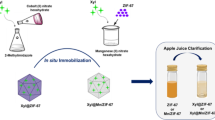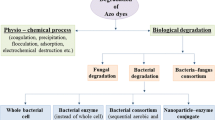Abstract
A novel immobilisation system was developed for dye decolorisation using laccase produced by Ganoderma sp. KU-Alk4. The enzyme showed high efficiency in dye decolorisation when entrapped in Cu–Al and Cu-alginate beads. The former gave the highest activity but the enzyme activity survived longer in the latter. An experimental design of two 3 × 3 Latin Square experiments was applied to evaluate the effects of three different alginate compositions (low, intermediate and high mannuronate), concentration of alginate, (1.5, 3.0 and 4.5% w/v) and concentration of cross-linking agent, CuSO4 (0.075, 0.15 and 0.225 M) on the decolorisation of indigo carmine dye and residual laccase activity in beads. The most significant factor for residual activity was the concentration of the cross-linking agent (P < 0.05) followed by alginate composition (P < 0.1). Increasing the alginate concentration resulted in only small increase in the dye decolorisation. However, higher laccase activity remained in 3.0% w/v alginate beads. Maximal dye decolorisation was achieved when 3.6% w/v low mannuronate alginate and 0.15 M CuSO4 was used. Optimal conditions were confirmed in an extended experimental run. Results are presented from 9 successive batch runs over 12 days, reaching 96% removal of the dye (216 mg/l).








Similar content being viewed by others
References
Ahn MY, Zimmerman AR, Martínez CE, Archibald DD, Bollag JM, Dec J (2007) Characteristics of Trametes villosa laccase adsorbed on aluminum hydroxide. Enzyme Microb Technol doi:10.1016/j.enzmictec.2006.12.014
Baldrian P, Gabriel J (2002) Copper and cadmium increase laccase activity in Pleurotus ostreatus. FEMS Microbiol Lett 206:69–74
Bourbonnais R, Paice MG (1990) Oxidation of non-phenolic substrates: an expanded role of laccase in lignin biodegradation. FEBS Lett 267:99–102
Brandi P, D’Annibale A, Galli C,Gentili P, Pontes ASN (2006) In search for practical advantages from the immobilisation of an enzyme: the case of laccase. J Mol Catal B: Enzym 41:61–69
Bucke C (1987) Cell immobilization in calcium alginate. Methods Enzymol 135:175–189
Campos R, Kandelbauer A, Robra KH, Cavaco-Paulo A, Gübitz GM (2001) Indigo degradation with purified laccases from Trametes hirsute and Sclerotium rolfsii. J Biotechnol 89:131–139
Chung KT, Stevens SE (1993) Degradation of azo dyes by environmental microorganism and helminthes. Environ Toxicol Chem 12:2121–2132
Claus H, Faber G, König H (2002) Redox-mediated decolorization of synthetic dyes by fungal laccases. Appl Microbiol Biotechnol 59:672–678
Couto RS, Sanromán MA, Hofer D, Gübitz GM (2004) Stainless streel sponge: a novel carrier for the immobilisation of the white-rot fungus Trametes hirsuta for decolourization of textile dyes. Bioresou Technol 95:67–72
Delanoy G, Li Q, Yu J (2005) Activity and stability of laccase in conjugation with chitosan. Int J Biol Macromol 35:89–95
Durán N, Rosa MA, D’Annibale A, Gianfreda L (2002) Applications of laccases and tyrosinases (phenoloxidases) immobilized on different supports: a review. Enzyme Microb Technol 31:907–931
Haug A, Larsen B, Smidsrød O (1967) Studies on the sequence of uronic acid residues in alginic acid. Acta Chem Scand 21:691–704
Kierstan M, Bucke C (1977) Immobilization of microbial cells, subcellular organelles and enzymes in calcium alginate gels. Biotechnol Bioeng 19:387–398
Knezevic Z, Bobic S, Milutinovic A, Obradovic B, Mojovic L, Bugarski B (2002) Alginate-immobilized lipase by electrostatic extrusion for the purpose of palm oil hydrolysis in lecithin/isooctane system. Process Biochem 38:313–318
Lante A, Crapisi A, Krastanov A, Spettoli P (2000) Biodegradation of phenols by laccase immobilised in a membrane reactor. Process Biochem 36:51–58
Palmieri G, Giardina P, Bianco C, Scaloni A, Capasso A, Sannia G (1997) A novel white laccase from Pleurotus ostreatus. J Biol Chem 272:31301–31307
Palmieri G, Giardina P, Desiderio B, Marzullo L, Giamberini M, Sannia G (1994) A new immobilization procedure using copper alginate gel: application to a fungal phenol oxidase. Enzyme Microb Technol 16:151–158
Palmieri G, Giardina P, Sannia G (2005) Laccase-Mediated Remazol Brilliant Blue R decolorization in a fixed-bed bioreactor. Biotechnol Prog 21:1436–1441
Peralta-Zamora P, Pereira CM, Tiburtius ERL, Moraes SG, Rosa MA, Minussi RC, Durán N (2003) Decolorization of reactive dyes by immobilized laccase. Appl Catal, B: Environ 42:131–144
Robles A, Lucas R, Martínez-Cañamero M, Omar NB, Pérez R, Gálvez A (2002) Characterisation of laccase activity produced by the hyphomycete Chalara (syn. Thielaviopsis) paradoxa CH32. Enzyme Microb Technol 31:516–522
Teerapatsakul C, Parra R, Bucke C, Chitradon L (2007a) Improvement of laccase production from Ganoderma sp. KU-Alk4 by medium engineering. World J Microbiol Biotechnol 23:1519–1527
Teerapatsakul C, Abe N, Bucke C, Kongkathip N, Jareonkitmongkol S, Chitradon L (2007b) Novel laccases of Ganoderma sp. KU-Alk4, regulated by different glucose concentration in alkaline media. World J Microbiol Biotechnol 23:1559–1567
Tien M, Kirk TK (1988) Lignin peroxidase from Phanerochaete chrysosporium. In: Wood WA, Kellogg ST (eds) Methods in enzymology. Academic Press, Inc., 161, pp 238–248
Vanhulle S, Radman R, Parra R, Cui T, Bols CM, Tron T, Sannia G, Keshavarz T (2006) Effect of mannan oligosaccharide elicitor and ferulic acid on enhancement of laccases production in liquid cultures of basidiomycetes. Enzyme Microb Technol doi:10.1016/j.enzmictec.2006.10.002
Won K, Kim S, Kim KJ, Park HW, Moon SJ (2005) Optimization of lipase entrapment in Ca-alginate gel beads. Process Biochem 40:2149–2154
Zhang M, Wu F, Wei Z, Xiao Y, Gong W (2006) Characterization and decolorization ability of a laccase from Panus rudis. Enzyme Microb Technol 39:92–97
Acknowledgements
Grateful to The Royal Golden Jubilee Ph.D. Program of the Thailand Research Fund for support to CT. Thank to Department of Microbiology, Faculty of Science, Kasetsart University.
Author information
Authors and Affiliations
Corresponding author
Rights and permissions
About this article
Cite this article
Teerapatsakul, C., Bucke, C., Parra, R. et al. Dye decolorisation by laccase entrapped in copper alginate. World J Microbiol Biotechnol 24, 1367–1374 (2008). https://doi.org/10.1007/s11274-007-9617-y
Received:
Accepted:
Published:
Issue Date:
DOI: https://doi.org/10.1007/s11274-007-9617-y




